On the road to trading cryptocurrencies, I have worked hard all the way from a small retail investor with 5,000 yuan, and finally counterattacked into a middle class with 25 million!
Today, I will share my experience along the way with you.
The most important thing in cryptocurrency trading is capital management, don't put all your money in at once. I am used to dividing the funds into five parts, and I only take one part to operate each time, so even if I lose, I won't put myself under too much pressure. Moreover, I have set a rule for myself, if I lose 10%, I will withdraw immediately, no matter how the market is. If I lose 10% five times in a row, I will only lose 50%, but if I earn, the income will be more than that. Even if I am trapped, I can stabilize my mentality.
Following the market trend is always the most reliable strategy. When the market falls, don't think about buying the dip, that's not realistic at all. When it rises, a pullback is a golden opportunity, and buying the dip is much safer than stubbornly holding onto the bottom.
When choosing a coin, you have to have a poisonous eye. Try to avoid those coins that have skyrocketed, whether they are mainstream coins or altcoins. Coins that rise too quickly will also have a large callback幅度接下来, which is prone to being trapped
In terms of technical indicators, I use MACD the most. The DIF line and the DEA line cross below the 0 axis and break through the 0 axis, which is a buy signal. Conversely, if they cross and go down above the 0 axis, you have to reduce your position.
Don't try to add to your position easily! Don't add to your position if you lose, the more you add, the more you lose, and you may end up with nothing. Remember, stop losses when you lose, and add to your position when you profit.
Trading volume is also very critical. If the trading volume increases when the coin price breaks through at a low level, that is usually a big opportunity.
The most important point is to follow the trend and seize the trend! Combining the daily line, 30-day line, 84-day line, and 120-day line, you will know how to operate when which line starts to turn upwards.
There are risks and considerable opportunities in the path of trading cryptocurrencies.
Learning capital management, trend analysis, and coin selection is the only way to go from a small retail investor to a middle-class person like me.
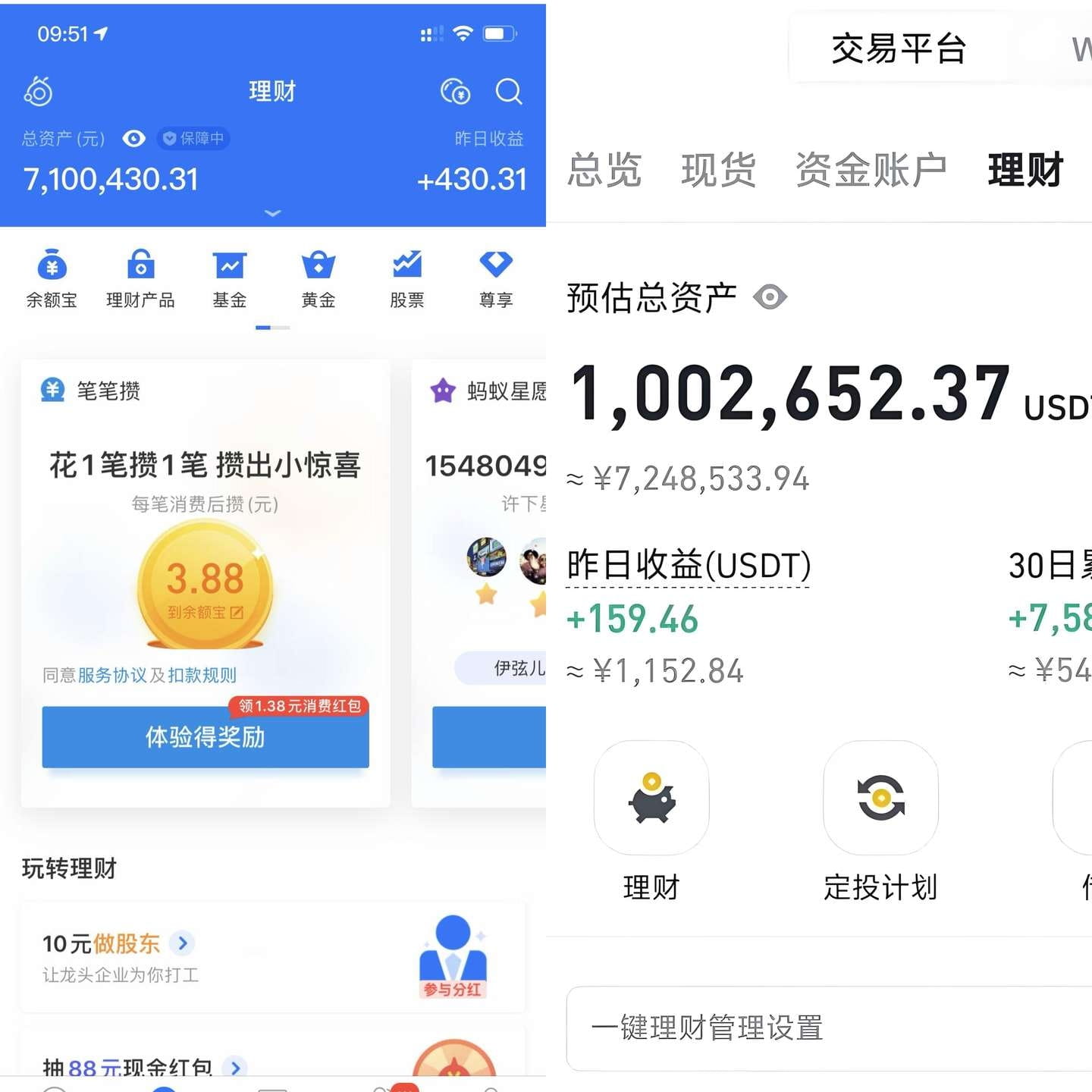
Must-see for beginners! Contract strategy relying on "light positions + following the trend"
I will only say this contract strategy once:
I call it——
Six-word mantra: light positions, control losses, follow the trend, add to positions, exit, compound interest

1 Light start:
The biggest problem with novices is that they go all-in to bet on right or wrong from the start.
My approach is: starting with no more than 1/10 of the total funds, even if I see it accurately, I only build a tentative position.
Contracts are not gambling, but controlling risk over a long period of time.
2 Loss control mechanism:
For every order, I set the stop loss point before opening the order, and the maximum loss per order does not exceed 5% of the total account.
Stop loss when you stop loss, never add to your position to carry orders.
People who dare to stop losses can survive for a long time.
3⃣ Adding positions with the trend:
My position is 'discounted and added,' not buying more as it falls, but adding when it rises!
Once the market verifies that the direction is correct, I will enter the market in batches, gradually add to the position, and magnify the profit.
4⃣ Don't add positions against the trend, only add positions with the trend
Those who understand will understand, adding to positions only serves the trend, and adding to positions against the trend will only lead to more losses.
I have specifically studied the establishment trajectory of large funds. True masters only add positions during an upward trend and never try to buy the dip.
5⃣ Planned exit:
Profit without cashing out = wasted effort.
The fans I lead take 20%-30% of their profits and leave every week, locking in their results, making them more stable mentally and in better shape.
6⃣ Compound rolling positions:
Withdraw half of the profit and continue to roll the remaining half,
In one round, profits are piled on profits, and the speed of small accounts doubling is far beyond your imagination.
It's not about shouting blindly, it's about strategy!
Contracts are not difficult, what's difficult is that you don't accept your fate
Liquidating every day is better than changing your mind——
May your next cash-out day no longer be out of reach.

Cryptocurrency novices become veterans, just master these ten golden rules!
Friends who haven't earned 1 million after trading cryptocurrencies for so many years, listen to me. If these ten suggestions don't work after following them, come find me!
1. If you don't have much money, you have to be careful. In a year, it is enough to seize an opportunity for a big rise. Don't always operate with a full position, leave some cash in hand in case of emergency.
2. Cognition determines how much money you can make. If you don't understand it, you won't make money. Simulated trading is okay to practice, but real money trading is very stressful.
3. If there is good news, if you don't sell it that day, you must quickly withdraw the next day when it opens higher. Once the good news comes out, everyone wants to sell, and the price will naturally come down.
4. As the holidays are approaching, reduce your position one week in advance, or simply don't sell. The market is not active during holidays, and prices are prone to large fluctuations.
5. For medium and long-term investments, you need to have money in hand. If the price rises, sell some; if the price falls, buy some. This will reduce costs and allow you to adjust your strategy at any time.
6. For short-term trading, you have to find those actively traded coins. If no one is buying or selling a coin, you can easily get stuck after you buy it.
7. Remember this rule, slow falls usually rise back slowly; sharp falls usually rebound quickly.
8. Stop loss is very important. If you buy the wrong thing, you have to admit it and stop loss quickly. Don't think about waiting for the price to come back, keeping your capital is the most important thing.
9. For short-term trading, look at the 15-minute K-line chart more and combine it with the KDJ indicator to find buy and sell points. Especially when KDJ is overbought and oversold, the signal is particularly accurate. You also have to look at indicators such as MACD and RSI.
10. Don't learn too many techniques, master a few is enough.
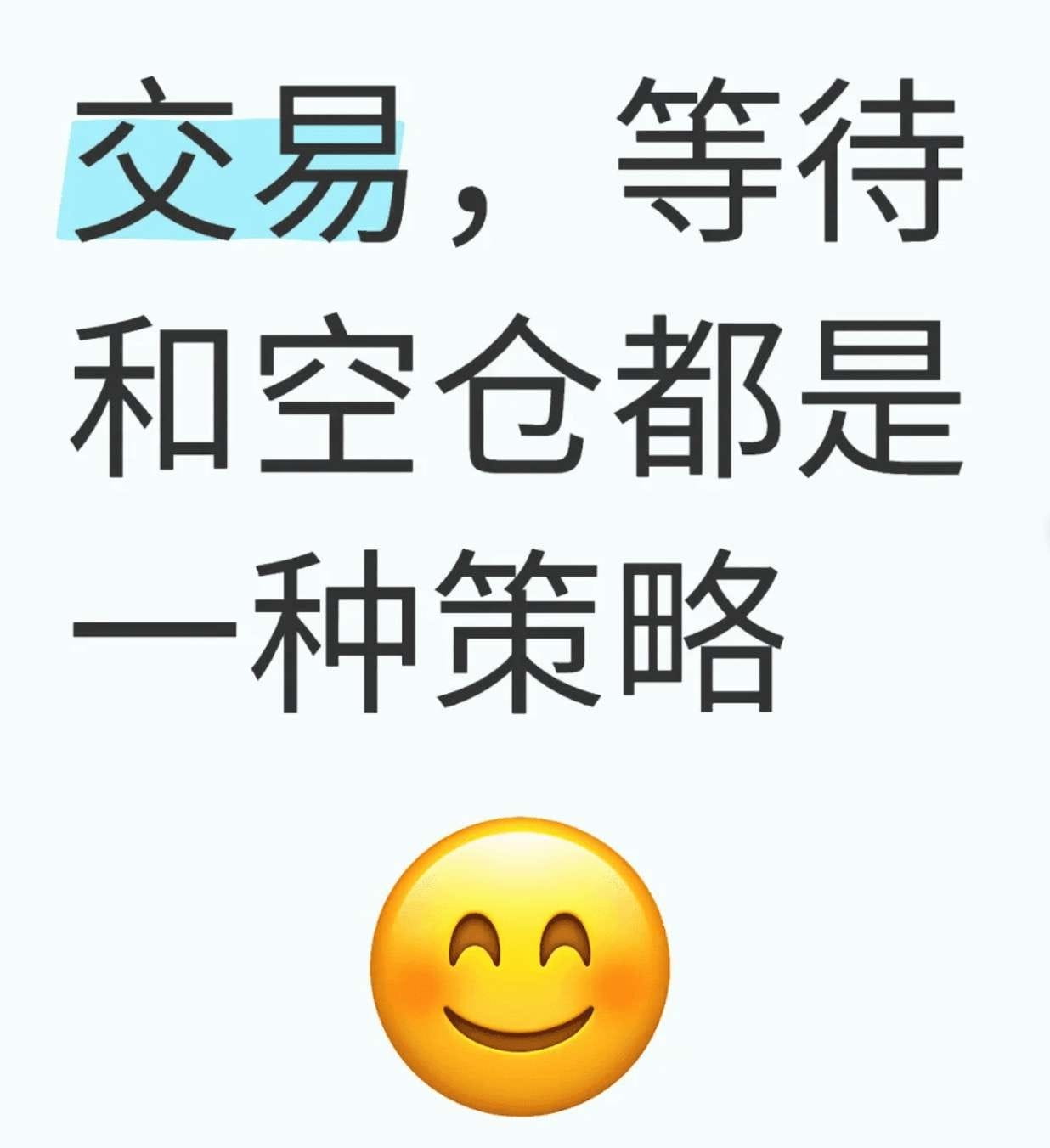
Trading is nothing more than doing four things well: selecting targets, buying points, selling points, and positions. Traders need to have an independent trading system to perform the above 4 actions. In trading practice, abc trading strategy has a stable winning rate and is simple and easy to understand
(I) Source of strategy and basic connotation
The abc trading strategy is an interpretation based on the abcd core trading theory independently developed by the teacher who teaches people how to fish. The teacher's strategy is used like a fish in water in the A-share market, and in combination with the trading characteristics of the cryptocurrency circle, Sunny has expanded the theory. The abcd core trading theory absorbs the theoretical essence of Dow Theory, Wave Theory, Turtle Trading Rules, Davas Box Theory, Trading Psychology, etc.
Figure 1 is a classic upward trend. The underlying logic is that the bottom is raised and the upward trend continues.
Figure 2 is a classic downward trend. The underlying logic is that the top is lowered and the downward trend continues.
Any K-line trend of any trading target is a constant repetition and superposition of these two classic graphics. A deep understanding of the following two classic graphics is the basic key to playing with abc trading strategies.
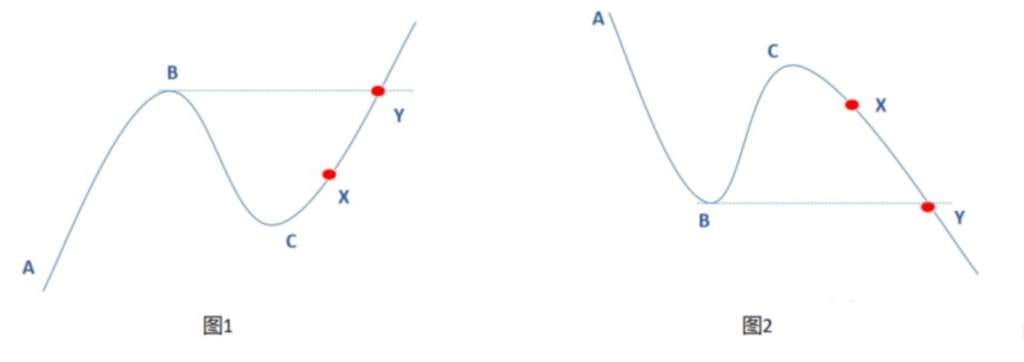
(II) Buying and Selling Points
The abc strategy is mainly based on right-side trading, pursuing a high winning rate, not pursuing extreme profits. It advocates building positions in batches, taking profits in batches, and stopping losses in batches to minimize risk.
Taking Figure 1 as an example, buy points appear at X and Y. The buy feature of the X point is "four advances" (the closing price exceeds the highest price of the 4 K-lines on the left), and the buy feature of the Y point is that the closing price exceeds point B. There are two stop-loss points, the first is "two exits" (the closing price of the current K-line is lower than the lowest price of the two K-lines on the left), and the second is point C, and all stop losses are at this point. The abc strategy allows for a certain position of left-side trading, and the key is to control the position and control the stop loss.
Real-world application to Figure 3, has formed an upward abc structure, arrow 1 is the "four advances" buy point (X and Y buy points mentioned in Figure 1 coincide in Figure 3 real battle). Two stop-loss points are the "two exits" and point C that may appear after arrow 1.
Note: "Four Advances and Two Exits" also comes from teaching people.
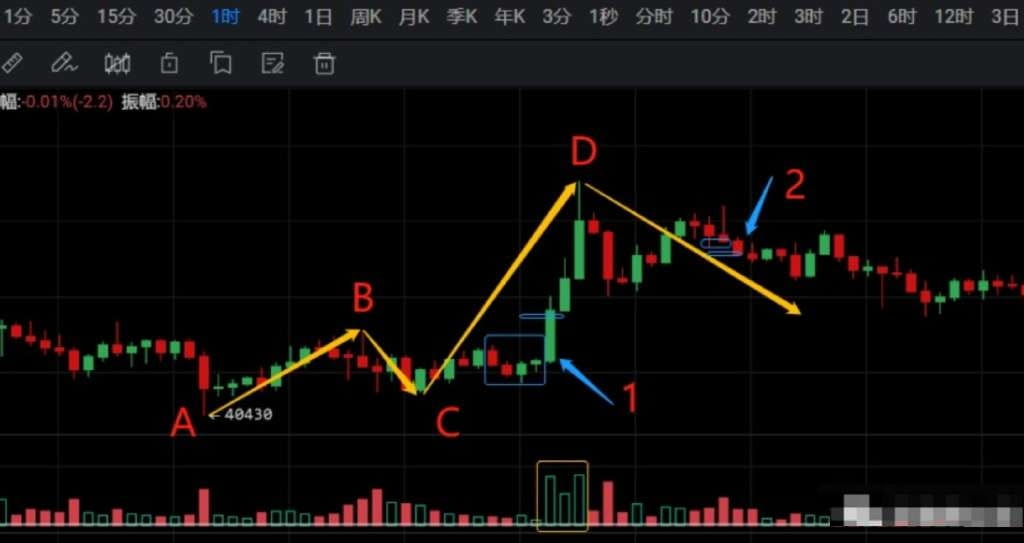
Compared to stop-loss points, the take-profit point model is more complex, with more dimensions to choose from, and needs to be taken profit in several times. The three most basic take-profit methods are:
1. "Two Exits" Take Profit. Arrow 2 in Figure 3, the closing price is lower than the lowest price of the two K-lines on the left, take profit.
2. Excess profit take profit. Any time dimension k-line shows a short period of rapid volume increase, that is, take profit part of the profit, which belongs to the left side take profit.
3. Multiple point overlap take profit. Draw a horizontal line at the closing price of point D, and if multiple points on the right side are near the same horizontal line, you can choose to take profit near that horizontal line.
In addition, there are also low-turnover take profit, critical point take profit, box doubling take profit, etc.
(III) Position
The size of the position determines the profit margin, and there are many factors, and the weights are different. The main principles are:
1. When the overall trend is upward, long positions can be opened with a higher proportion, while short positions should be opened with a lighter proportion. The opposite is also true.
2. The more significant the volume and yang wins over yin, the higher the position ratio, and the volume is flat, the position needs to be controlled. The opposite is also true.
3. Left-side opening should generally not exceed 1/4.
The above are the key points of the basic version of the abc strategy.
Based on this, combined with complex k-lines, with the goal of pursuing a higher win rate, it is also necessary to use Fibonacci retracement, multi-point connection, ascending/descending channel lines, triangles and other tools, and cooperate with abc strategy applications. The above content will be shared in the advanced version of the abc strategy, and at the same time, detailed explanations of left-side opening, more take-profit methods, "four no-go", "two no-exit" and other advanced gameplay will be given.
Cryptocurrency contracts are as addictive as gambling! As someone who has been there, I liquidated three times in one year and was in debt of 9 million, and then made a profit of more than 30 million, realizing financial freedom.
In the past two years, from November 2021 to September 2023, I took less than 400,000 and made it to more than 31 million. As someone who has been there, if you also want to use cryptocurrency trading as a second income, I would like to give some advice to those who are just entering the cryptocurrency circle:
First: Don't operate emotionally. Making orders is not about releasing emotions, not because 'it's too weak, I want to short it,' and not because 'I feel like it's going to rebound.' Any order that is not supported by logic and a system is giving money away.
Second: Controlling positions is more important than anything. You think you die in the market, but you actually die in the position. A full position in the opposite direction, no matter how good the strategy is, is useless.
Third: Stop loss without hesitation. Many people die by 'let's watch for a while,' and end up going straight to hell. Mature traders don't not make mistakes, but they know they are wrong and admit it immediately.
Fourth: Do familiar markets, don't touch coins that you don't understand. Don't touch what you don't understand, don't chase what others are shouting, and don't chase high what rises too sharply.
Fifth: Set up a clear trading system and execute it resolutely. Including entry logic, take-profit and stop-loss rules, and position increase and decrease standards. Execution is more important than the strategy itself.
Sixth: Acknowledge that you are an ordinary person, and don't fantasize about getting rich overnight. Truly great people don't double their money every day, but steadily outperform 90% of people. It's not about earning quickly, but about living long.
Seventh: Trading is not the whole of life, you must reserve emotional space. Don't tie all your emotions to profit and loss, otherwise it is easy to go from "losing money" to "losing control".
The last, and most important, is: if you want to make big money, first learn not to lose money. This is a market that goes against human nature. If you want to take money from others, you must be calm, rational, and patient enough.
If you do this, then your asset curve must be upward. It can even be said that: 95% probability, you will achieve considerable financial growth.
Brothers who play contracts, it's not that you don't work hard, it's that you've taken the wrong path from the start.
Do you always feel like you "understand the market"? As a result, you are either liquidated in advance, or you take profits and turn them into losses?
The direction is right, but the rhythm is all wrong; you have the technology, but the account is still dropping.
That's not that you're 'unlucky,' it's that you didn't understand how contracts work from the beginning.

You think opening contracts is 'investing'? Wrong. You are betting in a casino built by a market maker.
Every point, every rebound, every wash in the K-line has a complete script behind it.
While you are still struggling with 'should I add to my position', the system has already identified your position direction, liquidation position, position addition point, and stop loss line.
That bit of technical graphics and trend judgment is already a pre-set harvesting path in the eyes of the exchange.
Let's talk about position size. Many people like to 'go all-in with a heavy position.' But you don't understand that the more you increase your position, the more fees you pay, and the more slippage and mental stress you endure.
If you open 20x leverage, and the direction is wrong once, 10% is gone; if you carry the order without stopping the loss, the next round of the market will directly explode in your face.
The people who can really survive are not the ones with the strongest skills, but the ones who stop losses the most decisively, have the most stable rhythm, and have the most ruthless position control.
Do you know why you're still losing money even when you're doing the right thing?

It's that you don't set a stop loss and panic when it falls.
It's that you frequently chase orders and get carried away as soon as you move.
It's that you don't split your positions and go all-in as soon as you enter.
It's that you don't have a plan, and every order relies on feeling.
Contracts are not a shortcut for you to make quick money, but a hard battle of "systematic game".

You have to learn how to control positions, how to divide them in batches, how to set reasonable stop losses and take profits, and how to plan the rhythm of each order in advance. Otherwise, no matter how smart or hardworking you are, you will eventually become that 'fee receipt' from the exchange.
Stop fantasizing about doubling your money at once and getting rich overnight. The first step you can take is to stop making money-losing decisions.
Starting with understanding the rules, starting with learning to defend, slowly you will find that what really makes money is not the person who "wins the bet", but the person who understands the rules and can survive.
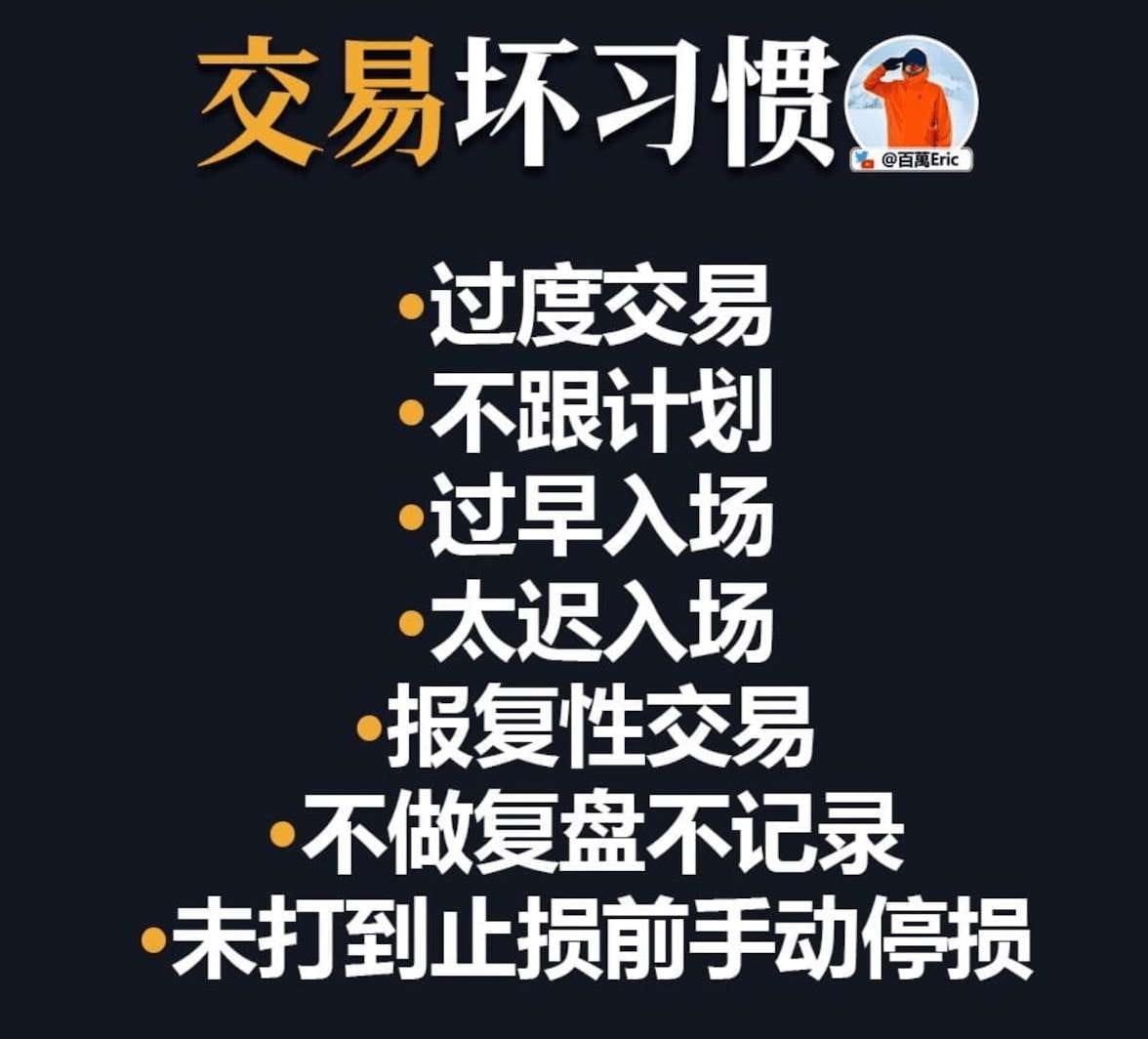
The eight important words in the cryptocurrency circle: the market is the best teacher, the nine important words in the cryptocurrency circle: rationality, moderation in advance and retreat, strategy, the ten important words in the cryptocurrency circle: good mentality, no hesitation, learning without end, adhere to these ten principles of trading cryptocurrencies; you will definitely reap a lot in the end
The cryptocurrency circle is not a shortcut to getting rich, but a battleground where only a few survive.
I. First recognize the market: This is a world where uncertainty is king

The essence of the market is not technical game, but a highly complex probability game
You must accept--no matter how brilliant the strategy is, it cannot be stably profitable in all environments. Any trading system that claims "100% win rate" is a scam.
What we can do is not to defeat the market, but to adapt to the market and use discipline to combat uncertainty.
Profit and loss are the same source: the way you make money determines the depth of your money loss Heavy position stud: may double, may also return to zero High leverage grab rebound: eat a bite of meat, but as long as the direction is wrong once, direct liquidation Reverse average down: sometimes can be unlocked, but in a unilateral trend is chronic suicide
Traders who can really survive are repeatedly betting on "probabilistic advantages" in a systematic way--earning more when they are right, and losing less when they are wrong.
II. Recognize yourself again: you are not a genius, let alone Liang Xi

Most people in the market don't die from ignorance, but from being self-righteous: obsessed with prediction: trying to grasp all the tops and bottoms, technical obsession: stacking indicators wildly, but ignoring position and risk control, superstitious about luck: attributing profits to themselves, blaming the market for losses, overconfident: - winning a few times in a row, thinking that they are invincible
Please remember: Discipline > technology, execution > inspiration, stability > stimulation,
Truly profitable trading is often boring.
III. The Underlying Logic of Making Money for Ordinary People

You don't need to be a genius, you just need to build a trading system that can be replicated and maintained.
1) Capital management: Only use a small portion of the total capital for each opening position, try out the trend with a light position and then add to the position after confirming the trend, don't go all-in with a heavy position from the beginning, the total position should not exceed 30%, leaving room for maneuver
2) Suitable for their own cycle: short-term: people with a strong sense of the market and quick reactions play wave bands: suitable for people who can withstand shocks and eat trends long-term: people who understand macro + fundamentals are more likely to win
3) The trading system should be simple, executable, and replicable. Trend strategy: Follow the trend, don't add positions against the trend. Swing strategy: Buy low and sell high, stop loss quickly. Arbitrage strategy: Cross-platform price difference, small fluctuation arbitrage, high win rate but
4) Stop loss and take profit must be mechanically executed, the stop loss line is set before entering, cut the position when the point is reached, take profit can be done in batches, don't be greedy, don't be cowardly, eating the middle section of the market is enough
5) Emotional management: Reduce the frequency of watching the market, avoid impulsive trading, accept losses, don't add to losses, don't become inflated after winning, write trading logs, and constantly review and optimize the system. IV. The Key to Truly Surviving: Mindset and Compound Interest
And the most difficult thing to defeat in the circle is not the market, but one's own greed and fear.
What you have to do is not "ten times a year", but annualized stable income + strict stop loss + not being cleared out by the market,
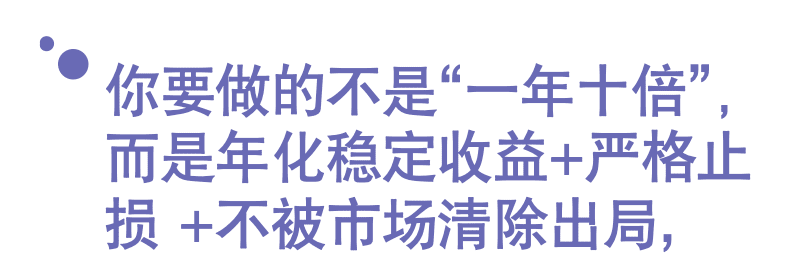
Don't underestimate the matter of 'living', compound interest is the only way for retail investors to compete with institutions: 30% annualized, 10 years is 20 times, 50% annualized, 10 years is 57 times, double in one year, and liquidate in the second year, it's 0
And if you accidentally lose——
Final advice: Don't become a "legend", please become a "survivor"
In the cryptocurrency circle, legendary stories belong only to a very small number of people, and most of the winners are ordinary people who can survive in the long market.
Make fewer mistakes, execute more, review frequently, and maintain rationality and patience.

The market is always changing, but the rules remain the same. Your only goal is: not to be washed out in this process of great waves washing away the sand. If you feel confused, you might as well bookmark this article as the starting point of your trading journey. Not to get rich quick, but to always be on the table.
1. When the market crashes, if your coin only drops slightly, it means that the market maker is protecting the market and preventing it from falling. You can hold such coins with peace of mind, and you will definitely gain in the future.
2. For novice buyers and sellers of coins, there is a simple and direct method: look at the 5-day line for short-term, hold as long as the coin price is above the 5-day line, and sell once it falls below; look at the 20-day line for medium-term, hold as long as ia is above the 20-day line, and exit once it falls below.
The best method is the one that suits you, the key is to persist in execution.
3. If the main upward wave of the coin price has formed and there is no significant increase in volume, then buy it decisively. Continue to hold when the volume increases and the price rises, and also hold when the volume decreases and the price falls but the trend is not broken; if the volume decreases and the price falls and breaks the trend, then quickly reduce your position.
If the coin price doesn't move within three days after a short-term purchase, sell it if you can.
If the coin iia falls after buying, unconditionally stop the loss if the loss reaches 5%.
5. If a coin has fallen 50% from its high point and has fallen continuously for 8 days, it means that it has entered an oversold state, and a rebound may occur at any time, so you can consider following up.
6. Choose leading coins when trading cryptocurrencies, because they rise the most sharply and are the most resistant to falling. Don't buy a coin just because its price has fallen a lot, and don't not buy it just because it has risen a lot. The most important thing about trading leading coins is to buy high and sell even higher.
7. Trade in accordance with the trend, and the price of buying is not the lower the better, but the more suitable the better. Don't easily say the bottom when falling, and give up those coins that perform poorly. The trend is the most important thing.
8. Don't get carried away by temporary profits, you must know continuous profit
It is the most difficult. You must seriously review whether your y profit is luck or strength. Establishing a stable and suitable trading system is the key to continuous profit.
9. Don't force yourself to trade without sufficient confidence. Being empty is also a strategy, and learning to be empty is very important. The first thing to consider when trading is to protect your capital, not to make a profit. Trading is not about frequency, but about success rate.